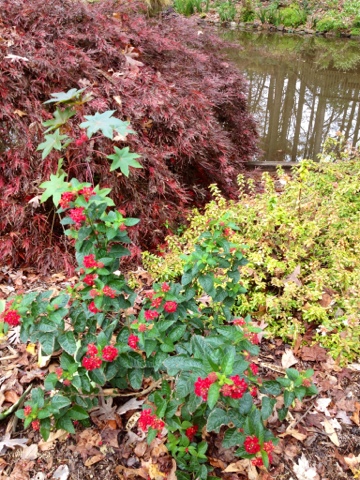On a crisp fall day I found myself walking through the JC Raulston Arboretum's Mixed Border in Raleigh, NC. It's always so exciting to revisit trees planted over 20 years ago that are still thriving.
The old trees are now mingled with a few of our own North America native species and newer specimens of cultivars and varieties ranging in origins from eastern Russia, Europe,Turkey, many Asian countries including: Japan, China, Taiwan, Vietnam, Korea. Look for the complete name tags (below) that identify the plants and the parts of the world where they grow naturally.
Euonymous europeaus 'Red Cascade' (above) is naturally found in the infamous hedge rows of England but underused in our landscapes.
Let me take you on a ramble over the a rustic stone path, through a central arbor and under this unique collection of trees with a series of images that I took a few weeks ago.
The specimens are old enough now to enjoy the unusual bark on limbed up trees planted close to the path edge.
I planted this Lagerstroemia limii (above) when The Mixed Border was first established in 1994-5. The seeds of this species of Crape Myrtle coming to the National Arboretum in 1981 from the Shanghai Botanical Garden , people's Republic of China were the beginnings of a breakthrough breeding program that brought the colorful mildew resistant Crape Myrtles we know today by American Indian cultivar names. The first to be introduced was the vibrant deep red flowering L. 'Arapaho'.
The central arbor seen from the east and west sides.
Gardenias are considered an 'old timey' Southern standard. This unusual variegated Gardenia (above) surely had it's evergreen origins in China. In my limited research I found out that the pure green leaved type was first grown in Charleston, SC in 1762.
Below, you can see a successful combination of a few of the woody plants at the west entrance to the Mixed Border. From the top down is Chinese Tulip Poplar tree and to the right of the Tulip Poplar the Nellie R. Stevens hedge with an arched passageway cut through. Progressing down see evergreen Daphniphyllum macropodum, Illicium, and closest to the ground, Spirea thunbergii 'Ogon'.
Fine golden leaves of Ogon Spirea can be a great textural change in a mixed border of shrubs and trees. Look up this plant to understand its origins and find out how Carl Peter Thunberg traveled from Sweden to Japan to bring back then unknown plants to European gardens. In 1775 Thunberg used the term 'Japonica' as an epithet for 254 species collected from Japan that had been introduced by the Japanese into their own country from China. How many times have you heard someone say "I have a Japonica."?
The Mixed Border is situated opposite The JC Raulston Arboretum's renowned Perennial Border. Thus it is a stellar example of how plants perform on the north side of a Nellie R. Stevens hedge that casts a 15' to 30' shadow over the entire 200' of garden. Homeowners can walk this border and take away ideas to implement in their own gardens that may have similar shady growing situations.
Visit The JC Raulston Arboretum any day of the year to experience this long narrow woodland garden walk in the presence of trees from all over the world.
Ps, The Mixed Border garden is cared for by Garden Leader Amelia Lane and "The Border Babes".... A dedicated group of talented gardeners in their own right. Staff support ranges from interpretive signage to propagation of new plants to trial. Additional vibrant volunteer groups of labelers, mappers and construction crew and others are vital to the overall success of this garden experience.
































